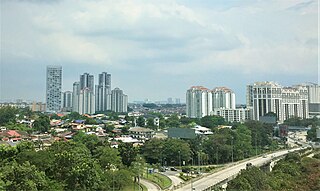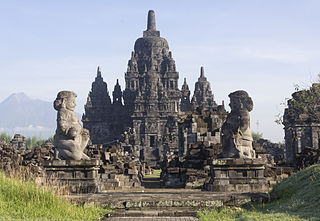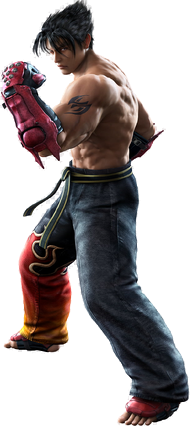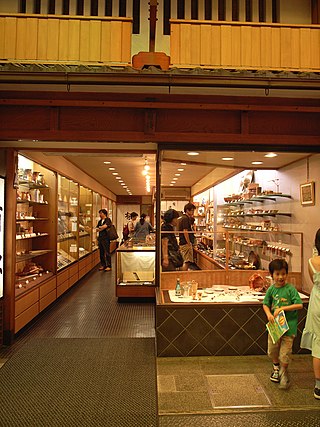
Kyoto, officially Kyoto City, is the capital city of Kyoto Prefecture in the Kansai region of Japan's largest and most populous island of Honshu. As of 2020, the city had a population of 1.46 million, making it the ninth-most populous city in Japan. More than half (56.8%) of Kyoto Prefecture's population resides in the city. The city is the cultural anchor of the substantially larger Greater Kyoto, a metropolitan statistical area (MSA) home to a census-estimated 3.8 million people. It is also part of the even larger Keihanshin metropolitan area, along with Osaka and Kobe.

Tekken 4 (鉄拳4) is a fighting game developed and published by Namco as the fourth main and fifth installment in the Tekken series, following the release of the non-canon title Tekken Tag Tournament in 1999. It was released on arcades in 2001, and on the PlayStation 2 in 2002.

Petaling Jaya, colloquially referred to as "PJ", is a city in Petaling District, in the state of Selangor, Malaysia. Originally developed as a satellite township for Kuala Lumpur, the capital of Malaysia, it is part of the Greater Kuala Lumpur area. Petaling Jaya was granted city status on 20 June 2006. It has an area of approximately 97.2 square kilometres (37.5 sq mi).

A Buddhist temple or Buddhist monastery is the place of worship for Buddhists, the followers of Buddhism. They include the structures called vihara, chaitya, stupa, wat and pagoda in different regions and languages. Temples in Buddhism represent the pure land or pure environment of a Buddha. Traditional Buddhist temples are designed to inspire inner and outer peace.

Gion (祇園) is a district of Higashiyama-ku, Kyoto, Japan, originating as an entertainment district in the Sengoku period, in front of Yasaka Shrine. The district was built to accommodate the needs of travellers and visitors to the shrine. It eventually evolved to become one of the most exclusive and well-known geisha districts in all of Japan. Gion is the Japanese translation of the Buddhist term Jetavana. Yasaka Shrine, located in this district is the center of the Gion faith.

Jin Kazama is a character of the Tekken fighting game series created by Bandai Namco Entertainment. Introduced as the protagonist in the 1997 game Tekken 3, he has been the central character of the series from that game onwards. Trained by his grandfather Heihachi Mishima, Jin wishes to avenge the apparent death of his mother Jun Kazama by Ogre. Meanwhile Heihachi betrays Jin to awaken a genetic abnormality within his body known as the Devil Gene.

Heihachi Mishima is a character in Tekken fighting game series created by Bandai Namco Entertainment, serving as its main antagonist. Introduced as the boss character from the first Tekken video game from 1994, Heihachi appears as the CEO/leader of a military firm known as the Mishima Zaibatsu founded by his father Jinpachi Mishima. Heihachi was the protagonist of Tekken 2 and one of the two main characters of Tekken 7 along with his son Kazuya Mishima, furthermore Heihachi was a boss character in two additional main installments of the series. He is opposed by many of his relatives who wish for his death out of revenge and to take over the Mishima Zaibatsu. This happens across the series and one of the creators of Tekken Katsuhiro Harada has called it a "family feud". Heihachi wants to defeat his son and grandson, Kazuya Mishima and Jin Kazama respectively. Heihachi's backstory and motives are revealed in Tekken 7, in which he is killed by Kazuya and thus does not appear in Tekken 8. Heihachi has two known illegitimate children who are playable in the series, the first is the hero Lars Alexandersson, who debuted in Tekken 6; and the second is Reina, who was introduced in Tekken 8, uses some of his moves and has a similar personality, and is later revealed to be also a Devil Gene user as both Kazuya and Jin.

Kazuya Mishima is a character in Bandai Namco's Tekken fighting game series, who first featured as the protagonist in the original 1994 game and later became one of the main villains of the series since becoming the penultimate antagonist of Tekken 2. He later returns as the main co-protagonist of Tekken 7, before assuming his role as the main antagonist again in Tekken 8. The son of worldwide conglomerate Mishima Zaibatsu CEO Heihachi Mishima, Kazuya seeks revenge against his father for throwing him off a cliff years earlier. Kazuya becomes corrupted in later games, seeking to obtain more power and later eventually comes into conflict with his son Jin Kazama. Kazuya Mishima possesses the Devil Gene, a demonic mutation, which he inherited from his late mother, Kazumi Mishima, which can transform him into a demonic version of himself known as Devil Kazuya. Devil Kazuya has often appeared as a separate character in previous installments prior to becoming part of Kazuya's moveset in Tekken Tag Tournament 2 and later games. Kazuya Mishima is also present in related series media and other games.

Tekken: The Motion Picture is an anime adaptation of the Tekken fighting video game series by Namco. Produced by ASCII Corporation and Sony Music Entertainment Japan and animated by Studio Deen, it was originally released in Japan as a two-episode OVA in 1998, and as a full-length feature for Western releases. It was one of the first OVAs to use digital ink and paint.

Permas Jaya, with the official name of Bandar Baru Permas Jaya, is a suburb in Johor Bahru, Johor, Malaysia. It has about 40,000-45,000 residents. The Permas Jaya Bridge connects it with Kampung Baru Bakar Batu, Taman Sentosa and downtown Johor Bahru. The Second Permas Jaya Bridge is completed and had helped to reduce traffic jams. The new Eastern Dispersal Link has also been completed and opened for public on 1 April 2012.

Tekken (鉄拳) is a fighting game developed and published by Namco. It was originally released for arcades in 1994, and ported to the PlayStation the following year. The game was well-received by critics. It is the first entry in the Tekken series, with a sequel, Tekken 2, being released in 1995.

Bandai Namco Entertainment'sTekken media franchise is known for its diverse cast of characters hailing from various nationalities, all coming together to compete in the King of Iron Fist tournament. In addition to the human characters, Tekken also introduces non-human characters for comic relief, such as the bear Kuma, his love interest Panda, the boxing kangaroo Roger, and the dinosaur Alex. Certain characters like Jin Kazama, Kazuya Mishima, Lee Chaolan, and Jun Kazama have their own alternative versions. Each character has their own goals for participating in the tournament.

Jiroemon Kimura was a Japanese supercentenarian who was the verified oldest living person between Dina Manfredini's death on 17 December 2012 and his own death at age 116 years and 54 days on 12 June 2013. Kimura became the verified oldest living man on 25 September 2011 at the age of 114, upon the death of Peru's Horacio Celi Mendoza, and later also the oldest man in history whose lifespan is verified on 28 December 2012, when he surpassed the age of Christian Mortensen (1882–1998), as well as the only verified man who has lived to age 116.

Aritsugu is a Japanese knife and cooking utensil producer and store, founded by Fujiwara Aritsugu in 1560. It is one of the oldest knifemakers in Japan and one of the oldest companies in the World.

Tekken 7 is a fighting game developed and published by Bandai Namco Entertainment. It is the seventh main and ninth overall installment in the Tekken series, and is the first in that series to be released for PC. Tekken 7 was released to arcades in March 2015. An updated arcade version, Tekken 7: Fated Retribution, was released in July 2016, and features expanded content including new stages, costumes, items and characters. The home versions released for PlayStation 4, Windows, and Xbox One in June 2017 were based on Fated Retribution.

Kaiseki (懐石) or kaiseki-ryōri is a traditional multi-course Japanese dinner. The term also refers to the collection of skills and techniques that allow the preparation of such meals and is analogous to Western haute cuisine.

Owariya or Honke Owariya is the oldest restaurant in Kyoto, Japan; it was founded in 1465. The specialty are traditional buckwheat noodles, called soba. Japan's royal family has been known to eat at the restaurant. The restaurant uses the "freshest" Kyoto spring well water to make its soup broth.
















